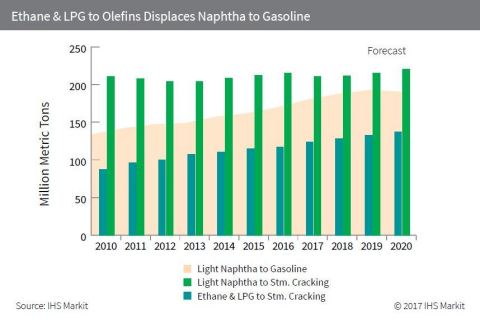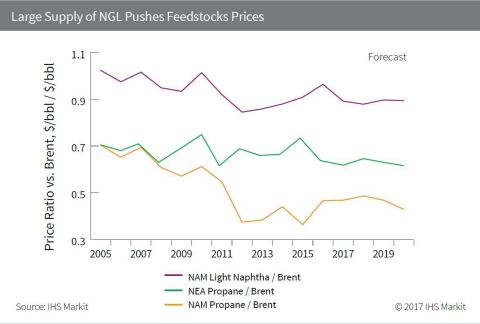HOUSTON--(BUSINESS WIRE)--Growing competition from less costly natural gas liquid (NGL) feedstocks—much of them coming from North American shale gas -- have dealt a blow to global demand for naphtha, according to new research from IHS Markit (Nasdaq: INFO), a world leader in critical information, analytics and solutions.
Naphtha, a refined petroleum product derived from crude oil and marketed in heavy and light varieties, is an important feedstock for production of petrochemicals and blendstock for gasoline. Together, light and heavy naphtha constitute about 40 percent of the global gasoline pool.
“Naphtha is no longer the dominant petrochemical feedstock it once was thanks to competition from the surging production of NGLs, particularly ethane and propane,” said Nick Rados, Ph.D., senior director at IHS Markit, and lead author of the recent IHS Markit analysis, “Light and Heavy Naphtha International Market Analysis: Balancing the Naphtha Surplus.”
Prior to the U.S. shale gas and tight oil renaissance, naphtha was the leading feedstock for petrochemical and gasoline production, Rados said, but the jump in production of ethane and propane feedstocks gave North American and Western European petrochemical producers a cheaper alternative to naphtha and a significant profit advantage. U.S. and Canadian NGL production has surged at an average annual growth rate of 6.2 percent, from 104 million metric tons (MMT) in 2011, to 141 MMT in 2016, due to supplies from both wet gas fields and tight oil production, and more growth is expected.
“Olefins producers with the existing flexible, or new, ethane-feedstock plants in the U.S., are enjoying an advantage due to lower feedstock costs, and for European producers, the access to abundant supplies of U.S. ethane feedstocks have given their plants new life,” Rados said.
“We are headed into an increasingly oversupplied market,” Rados said. “Demand growth for petrochemicals and gasoline has slowed due to a global economic slowdown, while many producers have been adding naphtha production capacity—resulting in excess of naphtha and depressed prices.”
Entering 2017, global demand for naphtha (including natural gasoline) is 1,180 MMT according to the IHS Markit report, and the demand growth has been projected to increase to nearly 1,260 MMT, by 2020. That translates to an average annual growth rate of 1.7 percent, a strong growth rate for a refined product, but not enough to absorb increasing production of both naphtha and NGLs.
While the global market for naphtha will be oversupplied until at least 2020, the IHS Markit analysis said, the propane market is even more oversupplied, with increasing production coming, not only from U.S. shale resources, but also from the Middle East and Russia. Propane prices were sliding before the onslaught of the U.S. shale renaissance, but since then, have plummeted, which in turn put downward pressure on prices for naphtha.
“The current length in the propane shipping fleet, along with the opening of the Panama Canal expansion supports incremental trade, but anticipated increase in crude and naphtha prices will drive even greater volumes of low-cost propane to Asia,” Rados said.
The abundance of petrochemical feedstocks is unlikely to end anytime soon, the IHS Markit report said, with Saudi Arabia, U.A.E., Kuwait, and Russia investing in more naphtha production capacity. For example, the recent addition of just one large condensate splitter (Novatek in Russia), has added 4 million tons of naphtha supply, or 3.5 percent of global naphtha trade.
Ethane imports to Western Europe have already started from both the Enterprise Products Partners terminal on the U.S. Gulf Coast and the Sunoco Logistics terminal on the U.S. East Coast. Those shipments will supply the European facilities of INEOS, SABIC, Reliance, ExxonMobil and others.
Rados said companies are essentially making two different bets on feedstocks in Europe. “While some have bet on excess of U.S. ethane (like those just mentioned above), others like Dow and BASF have bet on global oversupply of cheaper propane coming from Russia, the U.S. and Algeria.”
In spite of strong penetration of NGLs, a lighter, paraffinic naphtha is still the predominant feedstock for production of olefins, such as ethylene and propylene, while heavy naphtha remains the most important feedstock for production of high-octane gasoline and aromatics chain products, such as polystyrene, PET (polyethylene terephthalate) plastic and polyester fiber. Gasoline blenders are also at an advantage in the current market, Rados said, because they can buy cheaper blendstock at lower prices. Naphtha is cheaper and octane is relatively cheap at present.
The current market oversupply does not mean that producers will not have investment opportunities in the near to mid-term, Rados said. “After 2020, we foresee a period where some markets could become short of naphtha, particularly heavy naphtha, if investments fall off today. Unlike with light naphtha that can be substituted with NGL feedstocks to make olefins, heavy naphtha is indispensable for production of PET plastic and polyester fiber, the fastest growing demand segment for naphtha.”
NOTE: The market outlook for naphtha and other petrochemical feedstocks will be key topics of discussion at the upcoming IHS Markit 32nd Annual World Petrochemical Conference (WPC), March 20 – 24, 2017, at the new Marriott Marquis Houston. WPC is the premier annual international gathering of chemical industry leaders, experts, government officials and policymakers, as well as leaders from key end-use markets and technology innovators. To view the current agenda for WPC 2017: 32nd Annual World Petrochemical Conference and register for the event or the training workshops, please visit: https://wpc.ihsmarkit.com/
MEDIA REGISTRATION: The WPC 2017 will include an on-site workroom for media, featuring internet access, ample workspace and a dedicated staff liaison to assist with facilitation of interviews. Credentialed members of the news media interested in covering the event can do so free of charge pursuant to their advanced registration approval, and their acceptance of the event media policy. Contact Melissa Manning at melissa.manning@ihsmarkit.com or +1 832-458-3840. Please send your name, organization, phone, e-mail and organization website.
To speak with Nick Rados, please contact Melissa Manning at melissa.manning@ihsmarkit.com. For more information about the IHS Markit analysis, Light and Heavy Naphtha International Market Analysis: Balancing the Naphtha Surplus, please contact nisha.keskar@ihsmarkit.com.
About IHS Markit (www.ihsmarkit.com)
IHS Markit (Nasdaq: INFO) is a world leader in critical information, analytics and solutions for the major industries and markets that drive economies worldwide. The company delivers next-generation information, analytics and solutions to customers in business, finance and government, improving their operational efficiency and providing deep insights that lead to well-informed, confident decisions. IHS Markit has more than 50,000 key business and government customers, including 85 percent of the Fortune Global 500 and the world’s leading financial institutions. Headquartered in London, IHS Markit is committed to sustainable, profitable growth.
IHS Markit is a registered trademark of IHS Markit Ltd. All other company and product names may be trademarks of their respective owners © 2017 IHS Markit Ltd. All rights reserved.





